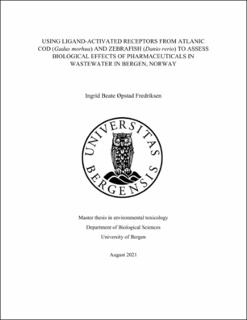| dc.description.abstract | Pharmaceuticals and personal care products are continuously released into the marine environment through wastewater. Understanding the possible biological implications of pharmaceuticals specifically may be particularly important as they are designed to be biologically active, and many of them are known ligands for nuclear receptors. Nuclear receptors are ligand-activated transcription factors and include a multitude of receptors such as the pregnane X receptor (PXR), androgen receptor (AR) and estrogen receptor (ER). PXR has an important role in regulation of enzymes responsible for biotransformation and transport of both xenobiotics and certain endogenous compounds. The AR and ER are vital in development and reproduction as they bind and mediate effects of androgens (e.g., testosterone) and estrogens (e.g., estrone). Common for these nuclear receptors is that they might bind both natural hormones and synthetic compounds such as several pharmaceuticals. The main goal of this thesis was to investigate the ability of mixtures of compounds present in wastewater and sludge to activate or inhibit zebrafish PXR, cod ARα and cod ERα. This was done by utilizing in vitro luciferase reporter gene assays where these receptors were exposed to sample extracts from wastewater influents, wastewater effluents, or sludge from five different wastewater treatment plants in Bergen, Norway. Additional targeted chemical analysis was conducted in order to establish what compounds were present in the samples. The reporter gene assays indicated the presence of PXR agonists in multiple wastewater influents and effluents, where several effluents clearly stood out as more potent activators. ARα activation was seen in fewer samples, although for both influents and effluents. No ERα activation was identified for any of the samples. Several wastewater extracts did however induce significant inhibition of cod ERα. None of the sludge samples activated any of the receptors. The targeted chemical analysis detected compounds at variable concentrations. Caffeine was detected at highest concentrations followed by acetaminophen, TCPP, and 5-H diclofenac for both influent and effluent samples. Additionally, metoprolol, carbamazepine, prednisolone, and octocrylene were detected at lower concentrations. Effluent from Knappen wastewater treatment plant (WWTP) was identified as the sample with highest total concentration of compounds. The findings of this thesis suggest that compounds and/or mixtures of compounds present in wastewater influents and effluents from WWTPs in Bergen, Norway can activate and inhibit certain nuclear receptors from zebrafish and Atlantic cod. The methods applied also uncovered elevated cytotoxicity in extracts where chemical analyses were inconclusive, implying that bioassays may work as a useful supplement to chemical analyses by indicating both biological activity and cytotoxicity of wastewater released into the environment. The thesis does however represent a narrow window of information. The targeted chemical analysis, singular sampling day and the three receptors chosen, provides only a compound specific, time specific, and receptor specific image of the possible biological effects of compounds in the wastewater released. | |
